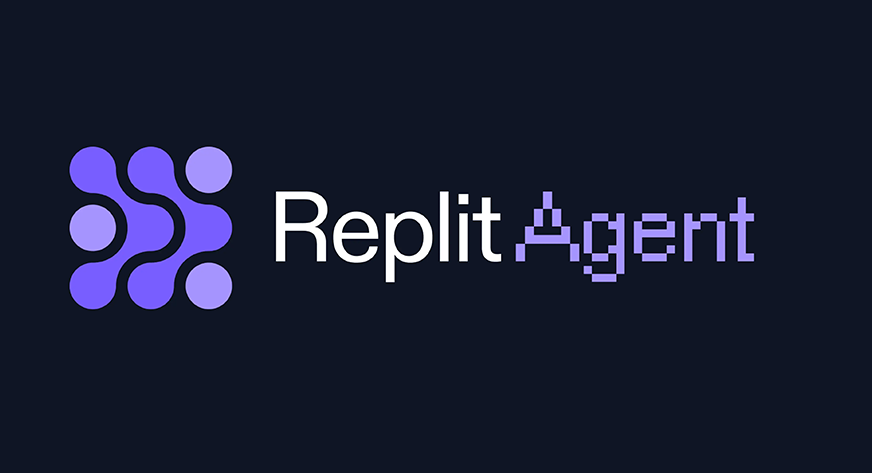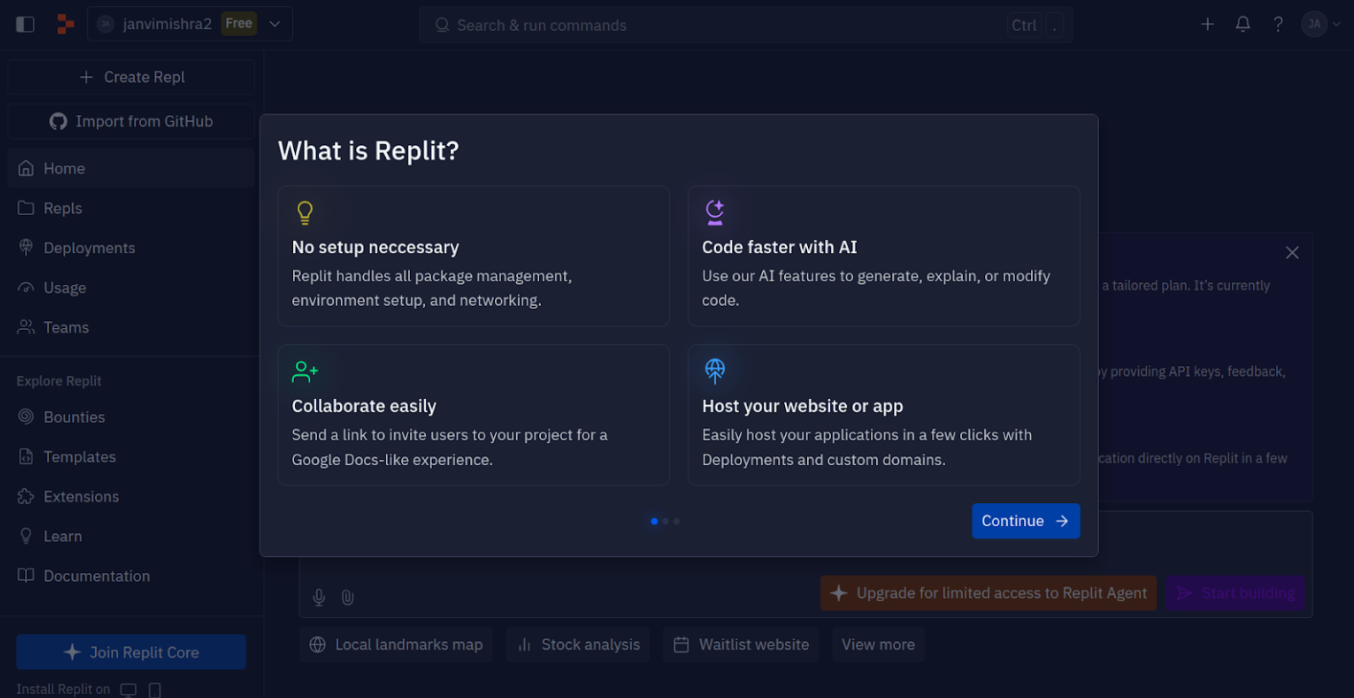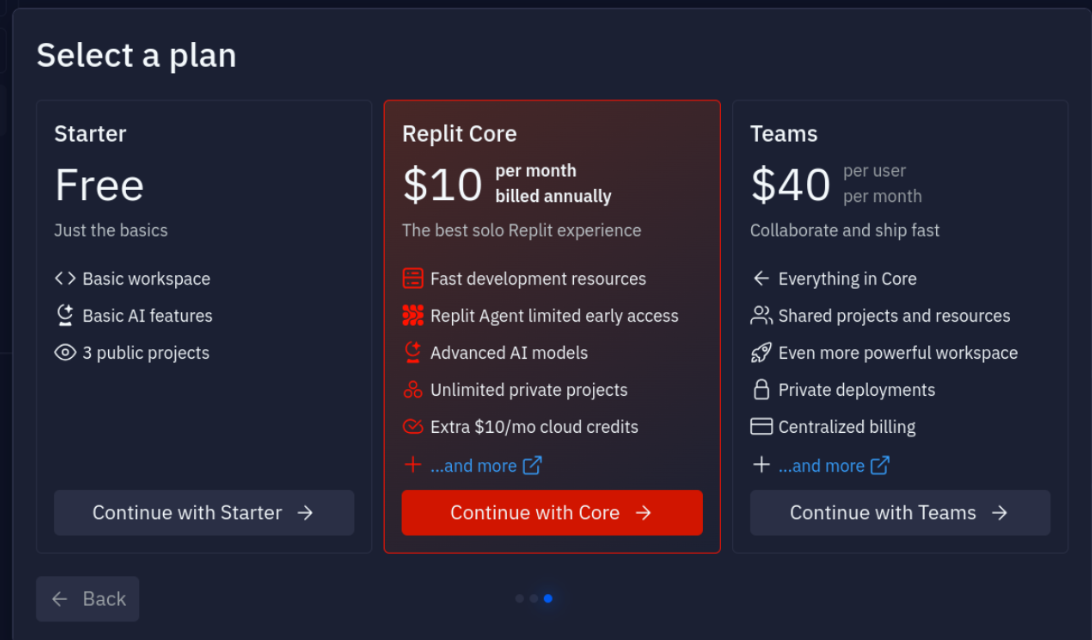Introduction
Imagine developing apps with the same ease as a conversation. There would be no complicated development environments to set up and no need to look through configuration files. Converting concepts into valuable apps can be a daunting task for many people. Installing different dependencies, setting up databases, and closely monitoring deployments are all necessary. These tiresome and time-consuming chores frequently cause even seasoned engineers to get stuck. Replit Agent seeks to streamline the procedure at this point.
Replit Agent is an ai solution that manages everything from environment setup to app deployment and generates code. Imagine this: you ask the agent to write the code, set up the database, and launch the application in just a few minutes, all to build a guestbook for your website.
Note: If you are looking for an ai Agent course online, then explore – Introduction to ai Agent

Overview
- Replit Agent simplifies app development by handling tasks like environment setup, code generation, and deployment using natural language prompts.
- It enables users to build and launch apps without complex configurations, offering a user-friendly interface for both beginners and experienced developers.
- Installation of Replit Agent is seamless within the Replit platform, requiring no extra downloads, and starts instantly after logging in.
- Use cases include automating testing, CI/CD pipelines, real-time collaboration, and setting up authentication or API requests.
- Despite its benefits, Replit Agent has limitations such as reliance on paid plans, potential accuracy issues, and dependency on the Replit ecosystem.
What is a Replit Agent?
Replit Agent is an ai-powered tool for creating software projects. It enables users of various skill levels to construct applications from scratch and comprehend natural language instructions, increasing the accessibility of software creation.
For the past few years, Replit has led an effort to make ai coding tools broadly accessible. With Replit Agent, the idea of human-machine symbiosis in a cooperative setting where humans and ai agents share knowledge and assistance gets one step closer.
Also Read: Replit Launches ai Code Repair Tool
How to Install Replit Agent?
Replit Agent is pre-integrated into the Replit platform and is operational immediately upon sign-in.
Step 1: Sign in with Replit or log in
Go to Replit and create a free account if you don’t already have one. If you’re already logged in, log in.

To use all of Replit Agent’s features, you must have access to Replit Core, which is only available to those with this subscription.

Step 2: Open Replit Agent.
Once logged in, the Replit IDE will have a “Replit Agent” button. It is visible in the dashboard for Core users so that you won’t miss it. The agent interface appears when you click this button, allowing you to engage with it immediately.

Step 3: Start coding with natural language prompts
You can now begin coding because the Replit Agent interface is open! Your demands can be typed in simple English, and the agent will handle the rest. From there, you may ask questions about the code it generates, add features, or give it further instructions.
And that’s it! You only need to log in to use Replit Agent within the Replit environment; no downloads or installations are required.
How to Use Replit Agent: Example Walkthrough
Let us examine Replit Agent in action with an example. Replit agents can generate code by entering a basic prompt, such as “Build a waitlist site for my startup.”

When we click on the “Start building” button, it will show the plan it has created and the requirements needed. If necessary, you can make some modifications or go with the same plan just by clicking on “Approve plan and start.”

When you approve a plan and start, Replit Agent automatically generates the app’s code. Flask generates the backend, and HTML, CSS, and JavaScript generate the front-end files.

Once the primary interface is created, the Replit Agent continuously refines the app based on our request. Here, the agent has made a front end that collects information about people.

After making all the necessary adjustments and ensuring everything functions as it should, it’s time to launch the app. It recommends autoscaling, static sites, and reserved virtual machines (VMs) for deployment.

Replit Agent assists in configuring deployment settings in this step, which includes defining build and execute commands, configuring database credentials, and selecting the suitable app type (e.g., web server). This is where we see the secrets, such as PGUSER and DATABASE_URL, specified securely for the deployment. After everything is in order, you may complete and publish your app, enabling users to access and utilize it.

And here is the final interface.

What are the Use Cases of Replit Agent?
1. Collaborative coding on the fly
- Problem: Managing multiple contributors and synchronizing real-time changes can be challenging during collaborative coding sessions.
- Prompt: “Enable real-time collaboration for this project.”
- Solution: Replit Agent configures a real-time collaborative environment, allowing multiple users to work on the same project simultaneously with synchronized changes.
2. Automate testing workflows
- Problem: Setting up and running test suites for projects can be tedious, especially for large applications.
- Prompt: “Set up unit tests for my Node.js app.”
- Solution: Replit Agent installs testing libraries like Jest or PyTest, generates test cases, and automates the running of these tests to ensure code quality.
3. Implement CI/CD pipelines
- Problem: Continuously integrating and deploying apps requires configuring a CI/CD pipeline, which can be complex.
- Prompt: “Set up a CI/CD pipeline for this project.”
- Solution: It configures the pipeline, integrates tools like GitHub Actions, and automates deployment processes, ensuring smooth, continuous integration and delivery.
4. Generate and handle API requests
- Problem: Writing boilerplate code for API requests can take valuable development time.
- Prompt: “Create API endpoints for this Flask app.”
- Solution: Replit Agent writes API routes, sets up request handling, and integrates with external APIs, streamlining the API creation process.
5. Create custom templates for future projects
- Problem: Repeatedly setting up similar projects can become a time sink, especially for commonly used structures.
- Prompt: “Generate a template for a Flask and PostgreSQL app.”
- Solution: It creates reusable templates for specific tech stacks, allowing you to jumpstart future projects with consistent setups.
6. Generate and manage cron jobs
- Problem: Scheduling background tasks requires careful configuration, especially for time-sensitive applications.
- Prompt: “Set up a cron job to run daily backups.”
- Solution: Replit Agent configures cron jobs for automated, scheduled tasks like data backups or email notifications.
7. Localize your application
- Problem: Adding multi-language support involves configuring libraries and managing translations, which can be cumbersome.
- Prompt: “Add localization to this project”
- Solution: It integrates localization tools, sets up language files, and updates your project to support multiple languages.
8. Monitor application performance
- Problem: Tracking performance metrics such as latency or resource usage is essential but can be complex.
- Prompt: “Set up performance monitoring for this app.”
- Solution: Replit Agent integrates performance monitoring tools and configures them to track key metrics, enabling you to monitor your app’s efficiency.
9. Set up authentication using OAuth
- Problem: Implementing OAuth for user authentication requires complex setups and configurations.
- Prompt: “Add Google OAuth login to my app.”
- Solution: It handles the OAuth integration, including generating client keys, configuring routes, and ensuring secure user authentication.
10. Create a CI/CD pipeline for automated deployments
- Problem: Deploying updates manually slows down the development process and introduces the risk of errors.
- Prompt: “Automate deployments after code pushes”
- Solution: It creates a CI/CD pipeline that automatically deploys changes to the live app after every code push, simplifying continuous delivery.
Best Practices for Using Replit Agent
Here are the best practices for using Replit Agent:
1. Provide Context for Every Task
When giving instructions, include relevant context to help the agent understand the bigger picture. For example, instead of just saying “create a homepage,” specify “create a homepage with a hero section, navigation bar, and a responsive layout.”
2. Use Step-by-Step Prompts for Complex Functions
If a function requires multiple actions or dependencies, it’s better to break it down into smaller tasks. For instance, start with “fetch data from the API” and then ask to “display the data in a table.” This helps avoid confusion and ensures each step is executed correctly.
3. Double-Check Code Consistency
ai-generated code might occasionally miss or skip minor details. After receiving the code, ensure that the structure, variable names, and logic are consistent with the rest of your project.
4. Request Alternative Solutions
You can ask Replit Agent for different solutions if you’re exploring multiple approaches. For instance, “Show me another way to optimize this function” or “Can you provide a more efficient algorithm for this problem?”
5. Ask for Best Practices
The agent can also offer coding best practices. For example, ask, “What’s the best way to structure this project?” or “How should I manage the state in this app?” This helps you maintain a clean, efficient codebase.
6. Incorporate Unit Testing Early
Prompt Replit Agent will generate unit tests and the code for critical projects. For example, “Write unit tests for this function” will help you catch potential bugs early in development.
8. Be Clear About Target Platforms
Specify whether the app will run on web, mobile, or desktop platforms. For example, “Build a mobile-friendly contact form” or “Set up a back-end server for a web app” ensures the agent generates platform-specific code.
9. Ask for Documentation and Comments
Prompt the agent to add comments or generate documentation to make your code easier to understand and maintain. For example, “Add comments to explain each function” or “Generate API documentation for this project.”
10. Prompt for Error Handling
Replit agents help you implement error-handling mechanisms. To ensure robust code, ask, “Add error handling for API failures” or “What’s a good way to handle invalid inputs?”
Limitations of Replit Agent
While Replit Agent is a valuable tool for streamlining the development process, it does come with some notable limitations that users should be aware of:
1. Free vs. Paid Plans
Replit Agent is only available to Core subscribers, which means users on the free plan miss out on its powerful features. The paid plan offers advantages like project scaffolding, multi-step tasks, and integrated deployment. Still, depending on your chosen pricing tier, it also comes with potential limitations on API calls and advanced features. Always check your subscription details to avoid exceeding usage limits.
2. Data Privacy
Privacy concerns are common when using ai-powered tools. Replit Agent keeps your code within the Replit platform with strict privacy measures, including encryption. However, for users working on sensitive or proprietary projects, reviewing Replit’s privacy policies is crucial to ensure compliance with your company’s standards. It’s also wise to consider the potential risks of storing your code on a third-party platform, especially for industries with stringent privacy regulations.
3. Accuracy and Reliability
Like any ai, Replit Agent is not infallible. ai-generated code can contain errors, inefficient practices, or fail to meet your project’s unique needs fully. As with any automated system, developers should thoroughly review, test, and optimize the code, particularly in security, performance, and scalability. While Replit Agent can significantly reduce development time, human oversight is essential to guarantee a high-quality final product.
4. Limited Customization
Replit Agent is designed to handle many development tasks, but its flexibility is limited. Complex projects with particular requirements may encounter difficulties, as the ai might not be able to understand or fully meet intricate needs. For users with complex tech stacks or unconventional frameworks, it’s built-in functionality might not offer the same level of control as manual coding, requiring more developer intervention.
5. Dependency on Replit Ecosystem
Since Replit Agent is integrated into the Replit platform, users become reliant on Replit’s ecosystem. While this can simplify development by offering an all-in-one environment, it may also pose challenges for developers who prefer or need to work outside Replit. Additionally, users migrating projects from Replit to other platforms may face compatibility issues or need to refactor specific code components.
6. Learning Curve for Beginners
While Replit Agent simplifies many tasks, beginners may still face challenges when interacting with the ai. Misunderstandings in prompts or unclear requests could lead to incorrect or incomplete code generation. Users unfamiliar with programming concepts may struggle to fully leverage Replit Agent’s potential or interpret and troubleshoot its output.
Conclusion
Replit Agent combines ai-driven development with user-friendliness to streamline the process of creating and launching apps. Even if it streamlines workflows and saves a lot of time setting up, users still need to be aware of its drawbacks, which include issues with accuracy, privacy, and dependence on the Replit ecosystem. They can be an effective tool for developers of all skill levels, assisting in converting concepts into fully functional applications with careful use and supervision.
If you want to become a Generative ai expert, then explore: GenAI Pinnacle Program
Frequently Asked Questions
A. Replit Agent is available to Replit Core subscribers. After signing in to your Replit account, you can access it directly from the Replit IDE by clicking the “Replit Agent” button.
A. Replit Agent is only available to users on the paid Core subscription plan. Free users won’t have access to its features.
A. Replit Agent can help build many projects, from web applications to API services, automation scripts, and more. It supports popular technologies like Flask, Node.js, PostgreSQL, and others.
A. Replit Agent can configure deployment settings and recommend deployment options like autoscaling or reserved virtual machines (VMs). It can handle database configurations and securely set deployment credentials.
A. Replit Agent can enable real-time collaboration by creating a synchronized environment where multiple users can simultaneously work on the same project.
A. Replit Agent generates functional code, but users should always review, test, and optimize the output to ensure it meets their project’s specific requirements. Verifying code accuracy is essential, especially for complex or security-sensitive tasks.
A. Replit takes data privacy seriously, offering encryption and privacy measures. However, sensitive or proprietary code users should carefully review Replit’s privacy policies to ensure compliance with their security standards.
A. Replit Agent can install libraries like Jest or PyTest to set up and run unit tests. It generates test cases and automates testing workflows to maintain code quality.
A. Replit Agent primarily focuses on web-based projects but can help build mobile-friendly web apps. Users may need additional tools outside the Replit ecosystem for dedicated mobile app development.







